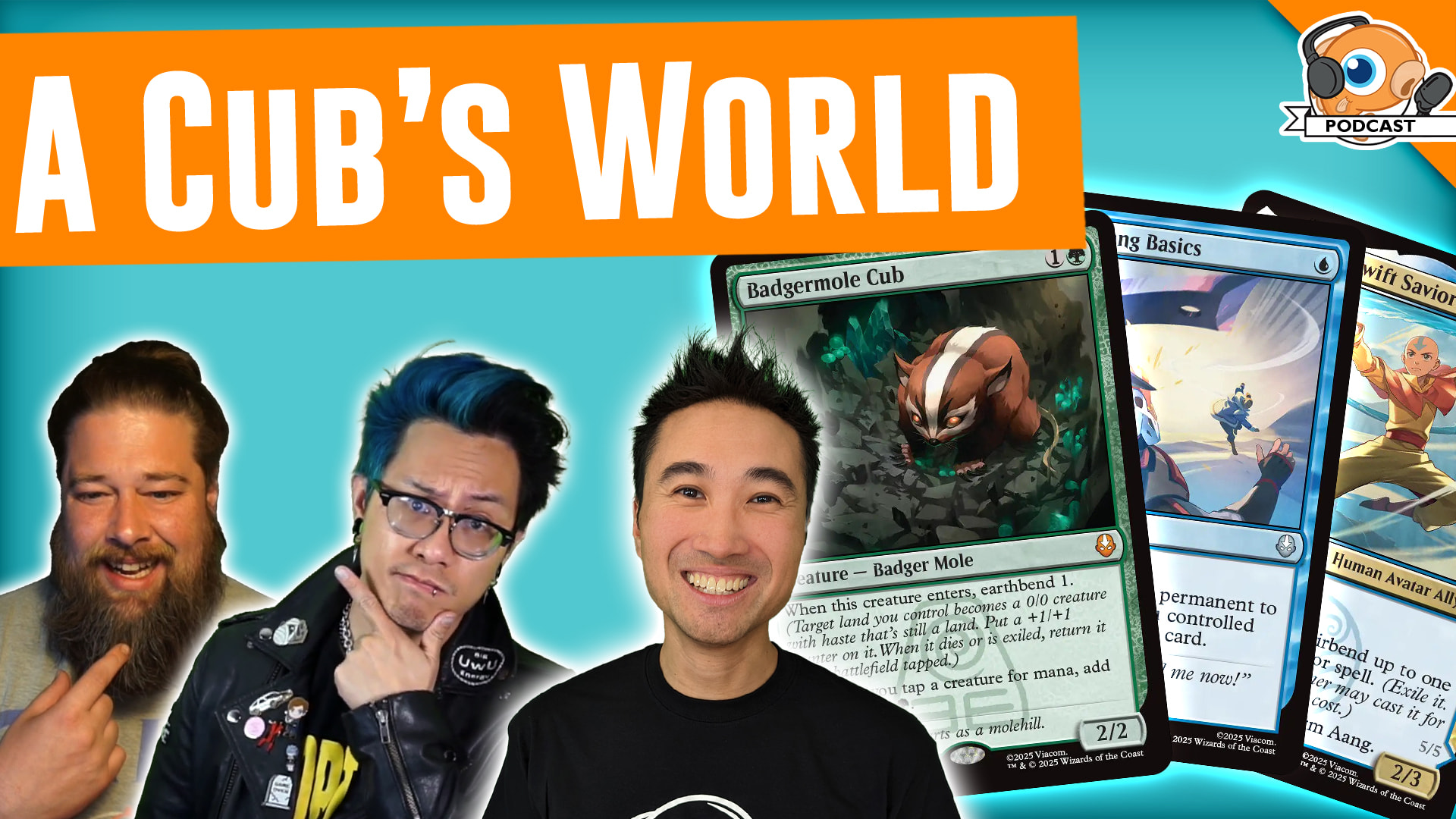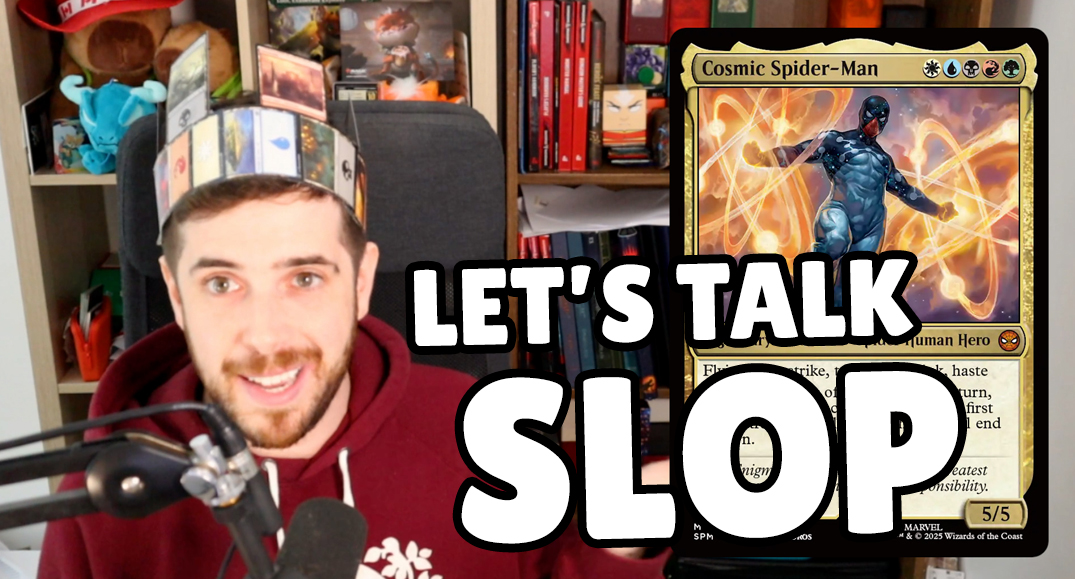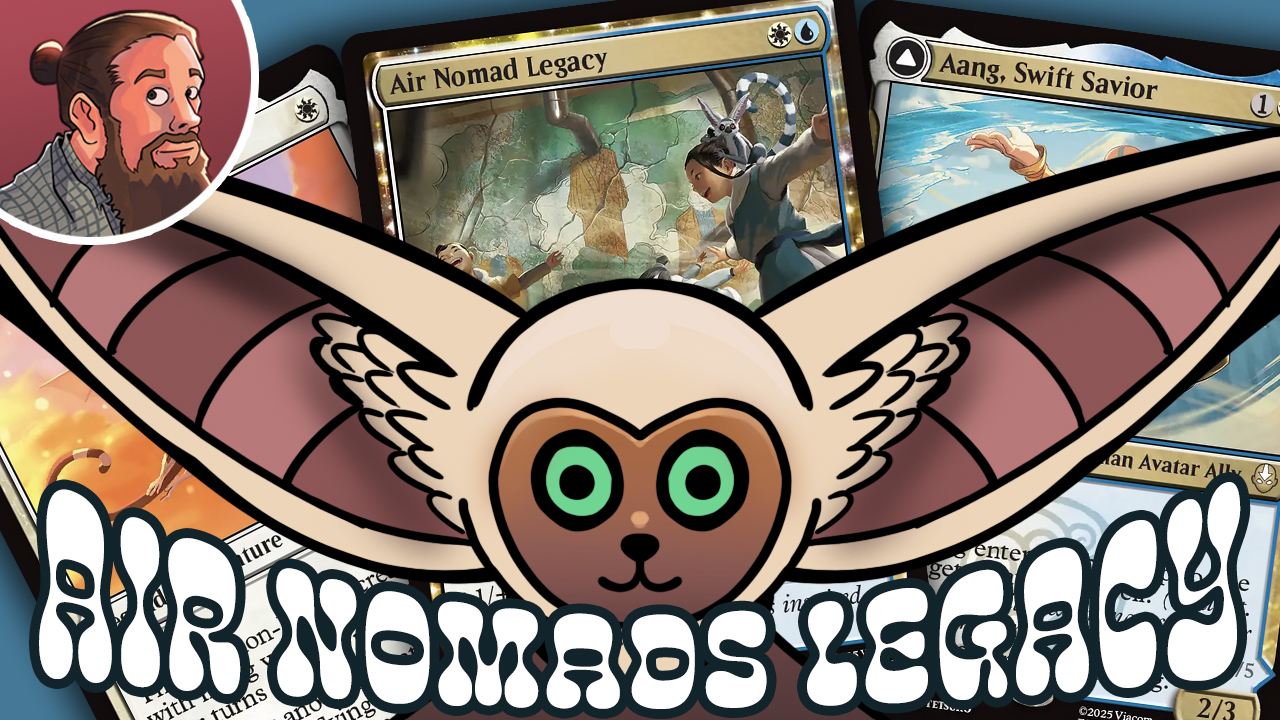Storm Scaling Potential Modern Reprints
The vast majority of cards that matter in Modern, that are powerful enough to be relevant in a format with that many cards, will horribly warp Standard. - Maro
The conversation about the need for Modern reprints has been heating up again lately, to the point where Mark Rosewater (Maro) felt the need to address the topic on his blog, blogatog. When I first read Maro's statement, I was confused, not so much by the statement itself, but by the strong language, especially "vast majority" and "horribly wrap." As such, I decided to investigate if the above statement is true. I mean, if almost all Modern playables would break Standard, maybe we should stop complaining about the lack of reprints in Standard legal sets. We all know the Thoughtseize and Mutavault reprints ended badly. Standard needs to be a fun and accessible introductory format for new players.
Now, one of the coolest things Maro does is maintain his Storm Scale, which is his rankings of how likely it is for a mechanic to make a return to Standard one day. The closer to "storm" a mechanic is on the scale, the less likely it is to make a return. Mechanics closer to evergreen are almost guaranteed to make a comeback. If you've never seen it before, check out the link, it's quite interesting. Today I've borrowed a page from Maro's book, and we are going to make our own Storm Scale, but instead of mechanics, we'll be looking at individual cards and attempting to judge just how much their return to Standard would "horribly warp" the format.
Important Stuff
A couple quick things before we get started. "Warp" is a fairly subjective term, but from my perspective it means two things. First, a card can wrap a format by dominating game play. The combination of fetch lands and battle lands was warping. Jace, the Mind Sculptor was warping. Collective Company is warping. However, we don't really have an objective way of judging "warping," it's more of a "I know it when I see it" thing. It might be temping to look at how much a card is played. This reasoning works in extreme cases, for example Mutavult, when a vast majority of Standard decks were playing four copies. In less extreme cases, seeing a lot of play doesn't really mean all that much as far as "warping" is concerned. There will always be a "most played" card in Standard. If you take away the "most played" card in a format, something else would fill the void.
Second, cards can be warping because they restrict design. For instant, Stoneforge Mystic keeps you from printing Batterskull. Oh wait. Let me rephrase that. Stoneforge Mystic should keep you from printing Batterskull. Restoration Angel isn't warping a Standard format on its own, but it does make you think twice about printing a card like Reflector Mage or Thragtusk. Even something simple like Elvish Mystic can be warping in the sense that it keep you from printing strong green three-drops. It's not a coincidence that, as soon as Elvish Mystic was banished, Wizards was able to print two Green, 3-casting cost planeswalkers in Nissa, Vastwood Seer and Nissa, Voice of Zendikar.
This scale is my personal list, so you'll probably disagree with at least some of my rankings, and that's great! Let me know in the comments where you think I went wrong, and together we can come up with a reasonable Storm Scale for Modern reprints!
Finally, the reprint conversation is more focused on prices than playability. Instead of using a list of the most played cards in Modern, which includes Commons and Uncommons, we'll be using a list of the 100 most expensive cards in Modern. By the end of the article we'll have every one of these cards slotted into one of six categories.
- 0: Currently (or recently) Legal in Standard. Includes cards that are Standard legal, or recently rotated.
- 1: Dual Lands. They get their own category, since there are a lot of them among the 100 most expensive cards in Modern.
- 2: Safe. Includes cards that should be fine in nearly all Standard formats. There may be rare situations (e.g. Scapeshift with Valakut, the Molten Pinnacle) where an otherwise safe reprint could warp the format.
- 3: Borderline. Includes a couple different types of cards. First are cards that I'm on the fence about, and second are cards that vary a lot based on the format. An example would be Eye of Ugin, which would horribly warp our current Standard format, but would be unplayable in many other Standard formats.
- 4: Unsafe. Includes cards that would warp pretty much any Standard format. Of course, I believe it is possible to design a Standard format where just about any card is safe, but it would require the design process to be extremely warped to accommodate the reprint.
0: Currently in Standard
The most obvious contradiction to Maro's statement comes from the fact that Wizards continues to print cards that are powerful enough to matter in Modern in Standard legal sets. Disregarding price for a minute and focusing exclusively on playability, we get some pretty interesting data. Out of the 50 most played creatures in Modern nine, were Standard legal in the past two years (from Theros to present). If we go back a little bit further to include Return to Ravnica, the numbers jumps to 16.
There are exactly 50 sets legal in the Modern format. There are a total of 12 sets in our "Theros to present sample" and 15 in the "Return to Ravnica to present Standard." As such, the creatures from Theros to present are represented in Modern slightly less than expected (if each set had equal representation), and the Return to Ravnica to present creatures are actually slightly over-represented. Even more interesting, 38 of the 50 most played creatures in Modern come from the mythic era (Shards of Alara to present), even though this group only contains 31 sets. As such, cards recently printed in Standard are actually more likely to see play in Modern than older cards.
Now, I heard you saying, "Duh, creatures have been powered up recently, while spells have been powered down, so it makes sense that most of the creatures in Modern come from recent sets." While this statement is true, the rate of spells isn't much different, with 34 of the 50 most played spells in Modern being from Mythic era sets and 13 from Return to Ravnica forward. So while the rate is slightly less than that of creatures, spells recently printed are still heavily represented in the Modern format.
As such, based solely on playability, the idea that a vast majority of cards that are powerful enough to matter in Modern will warp Standard seems questionable. If a card shows up in the 50 most played cards in Modern lists, it's obviously powerful enough to matter to the format. So either we've been playing some extremely warped Standards over the past few years, or the "good enough to matter in Modern = Standard warping" equation simply isn't true. That said, as I mentioned before, our primary focus is on expensive Modern cards. No on really cares that Negate is good enough for Modern and reprinted every year because it's a bulk common that everyone can access. How many of the 100 most expensive cards in Standard fall into the recently in Standard group?
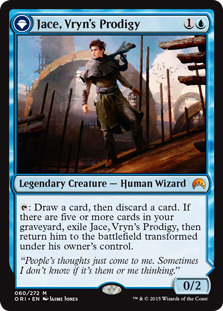
First up we have Jace, Vryn's Prodigy, which is currently Standard legal. Jace, Vryn's Prodigy provides an interesting example of simply being Standard legal doesn't mean a card is safe. I think most people would agree that Jace, Vryn's Prodigy is format warping, especially since it was printed in a Standard format featuring fetchlands, allowing it to flip consistently on the early turns of the game.

While not quite Standard legal since Fate Reforge rotated about a month ago, Ugin, the Spirit Dragon is close enough to Standard legal that it bears mentioning in this group. Is Ugin, the Spirit Dragon a very strong card? Indeed. But I don't think it can be called format warping. It's most common home towards the end of its Standard run was GR Eldrazi Ramp decks, and these decks have adapted and survived just fine without the eight mana planeswalker. In fact, the printing of Chandra, Flamecaller reduced the number of Ugin, the Spirit Dragons in Standard even while it was still legal, which to me means Ugin, the Spirit Dragon is not a "format warping" card, just an archetype staple.

Kalitas, Traitor of Ghet is the newest addition to the list, being printed just a couple months ago in Oath of the Gatewatch. Currently it's not even among the 10 most played creatures in Standard, which makes it difficult to call "format warping."

Collected Company might be the best card in Standard. It shows up across a wide range of color combinations, and has a major impact over deck building. While we can argue about whether or not Collected Company is too good for Standard, I'm going to err on the side of caution and put it in the "format warping" group.




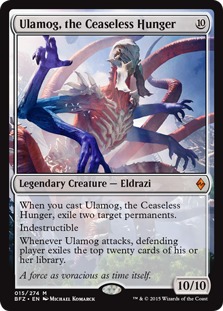
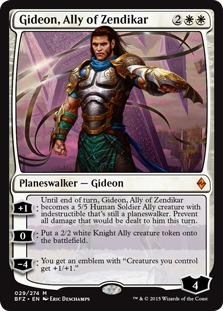
Monastery Mentor didn't do much in Standard. Chord of Calling is more powerful in older formats, but fine in Standard. Urborg, Tomb of Yawgmoth is pretty much a one-of in both Standard and Modern. Kolaghan's Command is another "better in Modern" card. Ulamog, the Ceaseless Hunger is good, but not warping. Gideon, Ally of Zendikar is a powerful card, no doubt, but probably about the right power-level for the "best planeswalker in Standard."
I do believe that Collected Company and Jace, Vryn's Prodigy are format warping cards, and I'd rather they not return to Standard in the near future. But the fact remains that Wizards, after extensive testing, deemed these cards "safe" within the past year, which is why they rank as zeros on the reprint scale. Regardless, 10 of the 100 most expensive cards in Modern get zeros on the reprint scale, because they are currently (or were recently) in Standard.
1: Dual Lands



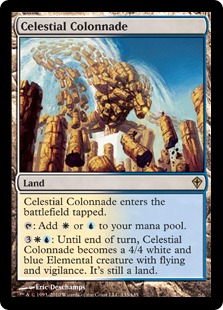
Unsurprisingly, many of the cards in Modern worth $20+ are lands, and here we need to break things down in two parts: dual lands and utility lands. As far as dual lands, I strongly believe that every single cycle could be reprinted in Standard without being format warping, at least by itself. We have seen that printing two synergistic land cycles, like fetch lands and fetchable dual lands in the same Standard can be problematic, but either one of the cycles is fine on its own. In fact, as far as Standard goes, some of the cycles that haven't been reprinted are arguably worse than cycles that have been printed.
While the quality of the land cycles in Standard certainly influences play — more untapped dual lands support multi-color aggro/tempo decks, while more tapped duals support grindy midrange and control strategies, when it comes down to it, most rare dual lands are relatively close in power level. I mean the original Alpha dual lands, the best cycle of lands ever printed, isn't that much better than shocklands, or even the Magic 2010 buddylands. While the Alpha duals would be somewhat better, the difference is less than many people would expect, and certainly not enough to warp Standard.
Overall, 22 of the 100 most expensive cards in Modern are dual lands. I did not include five-color lands like Cavern of Souls, colorless lands, or other non-dual utility lands. Each and every one of these dual lands are safe to reprint in Standard. Thus far, about one-third of the expensive cycles have been reprinted (the Onslaught/Khans fetches and Ravnica Shocks), with means we are still waiting for Zendikar fetchlands, the Future Sight cycle (especially Grove of the Burnwillows and Horizon Canopy), the Shadowmoor filterlands, the Worldwake creaturelands, and the Scars of Mirrodin fastlands, which are starting to creep up the list.
2: Safe
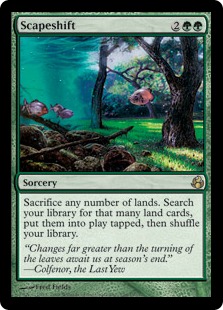
Scapeshift is a horrible card. Seriously, in a normal game of Magic you'd never want to have a copy of Scapeshift in your deck. Yet, Scapeshift is also a $50 card because if you are playing a deck with Valakut, the Molten Pinnacle, it suddenly becomes part of a game-winning combo. The thing is, in the entire history of Magic, we've had exactly one Standard format with Valakut, the Molten Pinnacle, which means that, over the past 23 years, Scapeshift would have been totally safe in Standard. Sure, there are other mechanics that might make Scapeshift passable (landfall, for example). With Scapeshift you don't need to design an environment around the card; you simply look at your upcoming sets, make sure they don't include Valakut, the Molten Pinnacle, and you are good to go.








I wanted to split up utility lands from dual lands, because unlike dual lands, not all utility lands are safe for Standard. That said, a "huge majority" of them are safe. All of the above lands rank among the 100 most expensive cards in Modern, and it's difficult for me to imagine a likely Standard environment where any of these cards would warp the format.
We recently had a five-color land legal in Standard in Mana Confluence, and it certainly wasn't format warping (or heavily played, outside of multi-color aggro decks), suggesting that cards like Glimmervoid and Tendo Ice Bridge would be very safe to reprint. If you are worried about Glimmervoid, the easy solution is to stick it in a "normal" Standard (where artifact are fringe players), rather than a set like Mirrodin or Scars of Mirrodin.
Since Wizards has made it abundantly clear they aren't going to print any playable land destruction spells, and even seem to by shying away from cards like Tectonic Edge and Ghost Quarter (I mean, if you are going to put these cards in Standard, you'd think a Standard with creaturelands would be the place), it's hard to envision any shenanigans with Flagstones of Trokir happening in Standard.
As for the Kamigawa lands, most of them are horrible and not likely to see much play in Standard. Pendenhaven could be interesting in some sort of green aggro deck, but without infect creatures, it isn't going to be too threatening, and we had a Vesuva variant in Standard (Thespian's Stage) not long ago, and it didn't see any play at all.


Look at your list of upcoming sets, make sure it doesn't include persist or undying and reprint Melira, Sylvok Outcast. Apart from being a combo piece (or hating on infect, which is a mechanic that deserves hate) Melira, Sylvok Outcast is a Grizzly Bear with the downside of being legendary.
Crucible of Worlds is similar. While a Strip Mine, creaturelands, or fetch lands could make the card warping in Standard, these formats are relitively rare. In most formats it would be - at best - an archetype staple. In fact, apart from the creatureland concerns, I wish Crucible of Worlds was legal in our current Standard for The Gitrog Monster shenanigans.

Original Elspeth is okay based mostly on Gideon, Ally of Zendikar, which is arguably just as good as Elspeth, Knight Errant in Standard. From my perspective, if Gideon, Ally of Zendikar is safe for Standard, then Elspeth, Knight Errant is safe for Standard as well.


Stony Silence and Leyline of Sanctity fall into a group of hate-cards that are typically much more important and impactful to older formats than the are in Standard. We have artifact versions of Leyline of Sanctity in a lot of Standard formats (Witchbane Orb and Orbs of Warding), and in Standard.
Meanwhile, Stony Silence would go completely unplayed in most Standard formats. In a typical Standard format there just aren't enough artifacts with activated abilities that see play for it to matter, which makes it abundantly safe to reprint.

Finally, we have Engineered Explosives, which is essentially a Ratchet Bomb that trades time for mana. It also has the downside of (almost) never being able to hit permanents with a converted mana cost of four or greater, while Ratchet Bomb can tick up to kill planeswalkers. While I could see an argument against Engineered Explosives in a Standard where the goal is to have a tier one token deck, most of the time it would be a fine sideboard card and not much more.


Considering we just had an upgraded (Merfolk synergies aside) version of Cursecatcher legal in Standard in the form of Judge's Familiar, and the upgraded version was somewhere between fringe and archetype staple in Mono-Blue Devotion, it's hard to construct a coherent argument as to why Cursecatcher would warp Standard. In fact, barring the reprinting of multiple Merfolk lords in the same format, it wouldn't see much play.




Keranos, God of Storms was a one-of throughout its Standard life.
Steel Overseer is a powerful, but slow lord. Apart from formats really dedicated to artifacts (like Mirrodin or Scars of Mirrodin) we typically don't have a playable artifact deck in Standard. In fact, I wish Steel Overseer was legal in our current format, because it might give a Thopter token deck a chance to compete in the top tiers of Standard.
Meanwhile, Abrupt Decay and Maelstrom Pulse are good removal spells, but are they really format warping? Abrupt Decay actually seems less powerful in Standard than something like Declaration in Stone, just because cards have higher converted mana costs in Standard than they do in Modern. In Modern, Abrupt Decay hits something like 90% of the format. In Standard you're hitting 50% of the format, which makes it more restrictive than Doom Blade. Maelstrom Pulse may be walking the line, but again, we just got Declaration in Stone, which is more efficient and in one color, but can't hit planeswalkers or random artifact/enchantments. We also just had Hero's Downfall, which is better than Maelstrom Pulse in a lot of situations. All things considered, I think Maelstrom Pulse is at the right power level for a "best removal spell in Standard" type card.

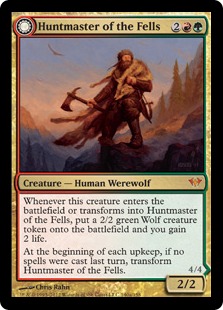


Creatures keep getting better and better, which makes it's hard to make reasonably arguments that many older creatures would warp Standard. I mean, just how good is Restoration Angel in comparison to Archangel Avacyn? Is Huntmaster of the Fells that much better than Siege Rhino? Kitchen Finks is a 3/2 for three, and Master of Etherium is a three mana lord that dies to artifact removal.
While this might sound contradictory, it is possible that these cards "warp" Standard, at least in the sense that they would be among the best creatures in the format. But the thing is there's going to be some "warping" creatures in every Standard format, because Wizards wants Standard to be about powerful, warping creatures. So why not make some of those warping creatures powerful Modern reprints?
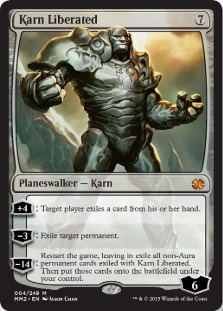
It's really, really hard for a a seven mana card to be format warping, regardless of how powerful it may be, which makes me think that Karn Liberated is a safe reprint. It didn't really do all that much during its run in Standard, and only shines in Modern thanks to the Tron lands. Plus we just had Ugin, the Spirit Dragon, and while Ugin, the Spirit Dragon was strong, I believe it fell short of warping the format.
3. Borderline (warping in some environments, probably fine in others)
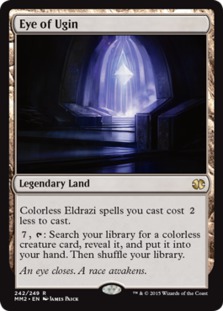
Putting Eye of Ugin here is more of a thought exercise than anything else, because it's not getting reprinted as long as it's banned in Modern. It does provide a good example of just how much environment impacts a card's power. In our current Standard format, Eye of Ugin would warp the format severly, but in many Standards it would be completely unplayable.
One thing Wizards has shown is that they care a lot about consistency, flavor and story, but with the end of core sets, this may have to change to some extent. Sure, maybe Eye of Ugin would look weird in Theros, but maybe having a little bit of weirdness would be acceptable if it was for the greater good of making Modern more accessible? How about one reprint each block of an expensive Modern card that doesn't fit the theme of the set at all, just to help with Modern prices?

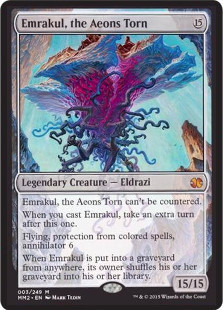
Through the Breach is likely safe in a lot of Standard formats. On the other hand, if you are putting something like Emrakul, the Aeons Torn or Grislebrand into play, it would warp the format. While I haven't analyzed each format, I expect that there are at least some formats where Through the Breach could slot into without causing problems. On the other hand, it does restrict design since R&D would have to watch what expensive, powerful creatures they printed for 18 months.
Emrakul, the Aeons Torn is similar. How much ramp is in the format? What turn can people expect to play Emrakul, the Aeons Torn? Maybe I'm being too optimistic, and I guess that the fact R&D would have to think about these things is warping to some extent, but there are certainly plenty of fun formats where Emrakul, the Aeons Torn wouldn't be warping.




Both Damnation and Oblivion Stone are board wipes that are a little bit more efficient than the board wipes that Wizards currently prints in Standard. Clearly, if Damnation was printed in Standard, it would push controlling decks towards black, which is warping in some sense, but isn't much different than Languish pushing current control decks towards black. That said, it's been made clear that both four-CMC wraths and anti-regeneration wraths are a thing of the past in Standard, so I wouldn't expect a reprint anytime soon.
As for Oblivion Stone, it's essentially a better Perilous Vault. It isn't that much better and Perilous Vault was safe in Standard in the not too distant past. That said, it's a colorless card, and I'm always weary of the warping potential of colorless cards since they can appear in any deck.


Voice of Resurgence and Cavern of Souls could very well return to Standard. From a design standpoint, they aren't especially problematic. On the other hand, as far as game play is concerned, they tilt the field against traditional control decks, which probably isn't a problem for Wizards, since they don't want draw-go control to be a thing in Standard. There is little doubt that putting these cards in a Standard format would have a huge impact on what decks are viable for the next 18 months.

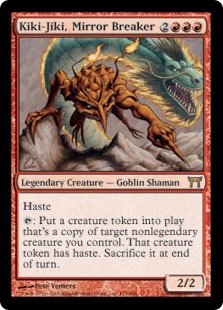




I'll admit that all these cards are borderline. Knight of the Reliquary is going to be good in every format that has Forests and Plains, but when there aren't any powerful utility lands to fetch up, it's mostly just a big beater.
Archangel of Thune is a good card, and it saw a lot of play during its first run in Standard, but it's real power is as a combo piece. Imagine Archangel of Thune and Archangel Avacyn were in the same format, which would see more play?
Linvala, Keeper of Silence and Gaddock Teeg are powerful hate cards, strong enough to keep some decks/archetypes/cards at bay. Whether this is a good or bad thing, it's really hard to say.
Spellskite doesn't really warp design, which might make it a fine reprint, but it can be pretty annoying to play against and phyrexian mana was a mistake. Even though I think it is safe for Standard, I also believe that it shouldn't be reprinted in Standard.
Kiki-Jiki, Mirror Breaker is potentially the most warping of the bunch, mostly because it would restrict the type of enter the battlefield triggers that could be printed in the same format. It's easy enough to avoid an infinite combo, but a Reflector Mage every turn could lead to an extremely unfun format. It's possible I should have put Kiki-Jiki, Mirror Breaker in the "warping" group, but it's hard to imagine a creature that costs five mana, has three red mana in its mana cost, and dies to Shock could do too much damage.

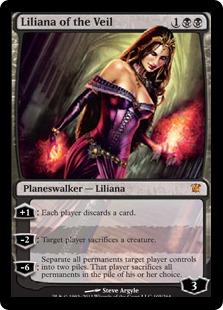
Inquisition of Kozilek is far less warping than Thoughtseize. That said, it still might be too good for Standard. Liliana of the Veil is also on the border of possibly safe and potentially warping. She would be good and heavily played, but warping? I'm not sure. All in all, I don't expect either of these cards to be reprinted in Standard anytime soon.

Last by not least, we have Academy Ruins which is another card whose value is heavily dependent on the format. If you stick it in a format with few artifacts, it would be perfectly fine. If you print it in Scars of Mirrodin, it could be warping. Here again we have the arguement for doing some odd looking, seemingly out-of-place reprints for the sake of Modern. While I don't expect Wizards to take this approach, it would be a good thing for the overall health of the game.
5. Unsafe (warping in nearly all environments)





While it pains me to write this, since Ensnaring Bridge, Blood Moon, and Worship all rank highly on my list of favorite cards of all time, there's little doubt that they would have a horrible warping effect on Standard. The problem is that these cards efficiently hate on things that Wizards wants Standard to be about, creature combat and being able to cast your spells. While I think it's theoretically possible to constructed a Standard environment where these cards could be (somewhat) safe, it's likely not worth the effort. I don't even want to think about how many new players would quite the game thanks to Worship and Blood Moon locks in Standard.
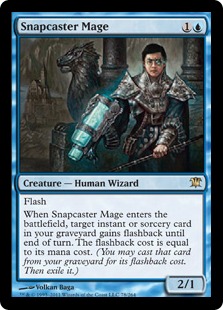
The problem with Snapcaster Mage is just as much about how it warps set design as about how it warps gameplay. If Wizards decides to put Snapcaster Mage in the set, they are making a decision to power down spells, especially cheap spells. As we learned last time Snapcaster Mage was in Standard, something as simple as an Unsummon (i.e. Vapor Snag) can become a Standard all star with Snapcaster Mage in the format. Sure, you could make a Standard where Snapcaster Mage wasn't the best card, but this trade-off simply isn't worth it and the Standard format would suffer as a result.

We know that Thoughtseize is format-warping, because it recently warped a Standard format, so I'm not going to take a lot of time breaking it down. This said, I do want to talk about the Thoughtseize reprint from a more meta-perspective. When people argue that Modern reprints are dangerous for Standard, the two most common examples they use are Thoughtseize and Mutavault, both of which warped their Standard formats when they were reprinted. The problem is that using these two cards as an example of why no expensive Modern cards should be reprinted in Standard legal sets is illogical. It's not that Modern staples are too good for Standard; it's that Thoughtseize and Mutavault are too good for Standard.
One of my fears is that bad experiences with Thoughtseize and Mutavault will keep Wizards from reprinting Modern cards that are safe in Standard legal sets. I mean, they do have a history of making a bad decision, and then letting that bad decision spiral into an even worse long-term decision — just look at the Reserve List. Was printing a massive supply of Chronicles a bad choice? Yes. Was taking a major stance against reprints necessary at the time? Most likely. However, guaranteeing no Alpha dual lands forever was a huge overreaction.
Along the same lines, not reprinting any more Modern staples in Standard because Thoughtseize and Mutavault warped their formats is an overreaction. Instead of throwing out the reprint baby with the Thoughtseize bathwater, learn from what went wrong with Thoughtseize and Mutavault, and make smarter reprint decisions moving forward, rather than giving up on the entire idea.
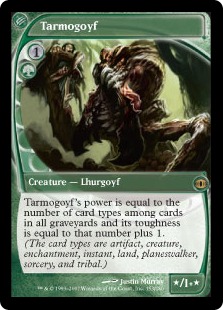







While all of these creatures are very different, they do have on thing in common. They are generically powerful in such a way that, almost regardless of what Standard format you drop them into, they are going to be one of, if not the best creature in the format. They are simply too efficient and/or resilient for Standard to handle. While I find it exceedingly unlikely that we'll ever see any of these cards in Standard again, if I had to rank them from least likely to be reprinted to most likely, it would be as follows:
- Arcbound Ravager (least likely)
- Fulminator Mage
- Sigarda, Host of Herons
- Goblin Guide
- Wurmcoil Engine
- Vendilion Clique
- Dark Confidant
- Tarmogoyf (most likely, although still exceedingly unlikely)



We know Mutavault was warping in Standard. While it was legal, the percentage of decks that played it was off the charts. That said, it's dominance was aided by the fact we were in a rare mono-colored Standard, which made the opportunity cost of playing the colorless creatureland extremely low. Would Mutavault be broken in Battle for Zendikar Standard where everyone was playing four or five colors with the help of fetchlands and battlelands? Probably not as broken, but colorless creaturelands are scary in Standard, just because they are so easy to slot in every deck. While Inkmoth Nexus and Blinkmoth Nexus aren't as powerful as Mutavault, a blanket ban on colorless creaturelands in Standard probably isn't a horrible idea. They have a lot of potential to get out of hand.




Aether Vial and Mox Opal are off limits because they allow players to cheat on mana in a manner that simply isn't acceptable in Standard. I mean, if we aren't allowed to have Elvish Mystic, we probably shouldn't have artifacts that can repeatedly tap for four mana or ones that add a mana of any color starting on turn one.
Chalice of the Void is an odd one. I almost put it in the "safe to reprint" section because the card just won't be very good in most Standard formats. The problem is, it would hate out on decks like Mono-Red Aggro or White Weenie, and it seems like Wizards wants those decks (at least one of them) to exist in most Standard formats. Plus, it leads to a lot of confusion. I can't tell you how many times I've seen players cast things into their own Chalice of the Void. And these are Modern players, who have most likely played with/against the card before. I expect Standard players who have been brought up on unplayable five-mana counterspells would riot.
Meanwhile, Batterskull is just too hard to deal with. While it might be (somewhat) safe in a format with a card like Kolaghan's Command, it's too easy for games to devolve into Batterskull wars with both players picking up and replaying Batterskulls every turn, while gaining life. The other vote against Batterskull is that it's colorless, and it's way easier for a colorless card to warp a format than a colored card.
Other "Warping" Cards:





- Bitterblossom is too efficient and hard to deal with for the small card pool available in Standard.
- Pact of Negation and Cryptic Command are a victims of Wizards distaste for counterspells. It's not so much that their powerlevel is warping, but I could imagine there'd be a lot of grumbling from Standard players who don't appreciate the beauty of Stasis locks and a stack full of counterspells.
- Noble Hierarch also falls victim to the new philosophy of Standard design. If Elvish Mystic is warping and Birds of Paradise is warping, than Noble Hierarch is double-warping.
- Gifts Ungiven offers too much value, at instant speed, and is just too easy to splash.
Wrap Up

First off, it's important to remember that this is my ranking. Please let me know where you disagree. Which cards did I put in the "safe" group that would horribly warp Standard? What cards did I put in the "0%" group that might be fine, given the right format?
The vast majority of cards that matter in Modern, that are powerful enough to be relevant in a format with that many cards, will horribly warp Standard. - Maro
Disregarding my numbers for a moment, it's pretty clear that Maro's statement is false. The problem is the language he used. First off, a "vast majority" of cards that matter to Modern were recently (over the past five years) in Standard, so either we've been repeatedly playing "horribly warped" Standard formats without realizing it, or the equation that good in Modern = warped Standard, simply isn't true. Second, using the adjective "horribly" was a horrible choice. It suggests that having powerful cards in Standard is a bad thing. Archangel Avacyn, Gideon, Ally of Zendikar, Collected Company, and any of the "best cards in Standard" are, by default, bad for the format and the game. The flaw with this logic is that Standard will always have a group of "best" cards that control the format. In a powered down format maybe it's Autumn Willow, in a more powerful format it's Siege Rhino.
Overall, my biggest issue is the lack of precise language. If he had said "some of the cards that matter to Modern would horribly wrap Standard," I wouldn't take issue. Of if he said something along the lines of "a vast majority of cards that matter to Modern could possibly be too strong for Standard," I'd give it a pass, but the combination of "vast majority" and "horribly wrap" paints a flawed picture of the difficulty of Modern reprints. While it is very true that some Modern staples are essentially unprintable in Standard-legal sets, there are plenty of Modern staples that would be fine for Standard.
Conclusion
Anyway, that's all for today. What do you think? What cards did I underrate? What cards did I overrate? What is your opinion of the idea that a "vast majority"of cards that matter to Modern would "horribly wrap" Standard? Leave your thoughts, ideas, opinions and suggestions in the comments, and you can reach me on Twitter @SaffronOlive, or at SaffronOlive@MTGGoldfish.com.


